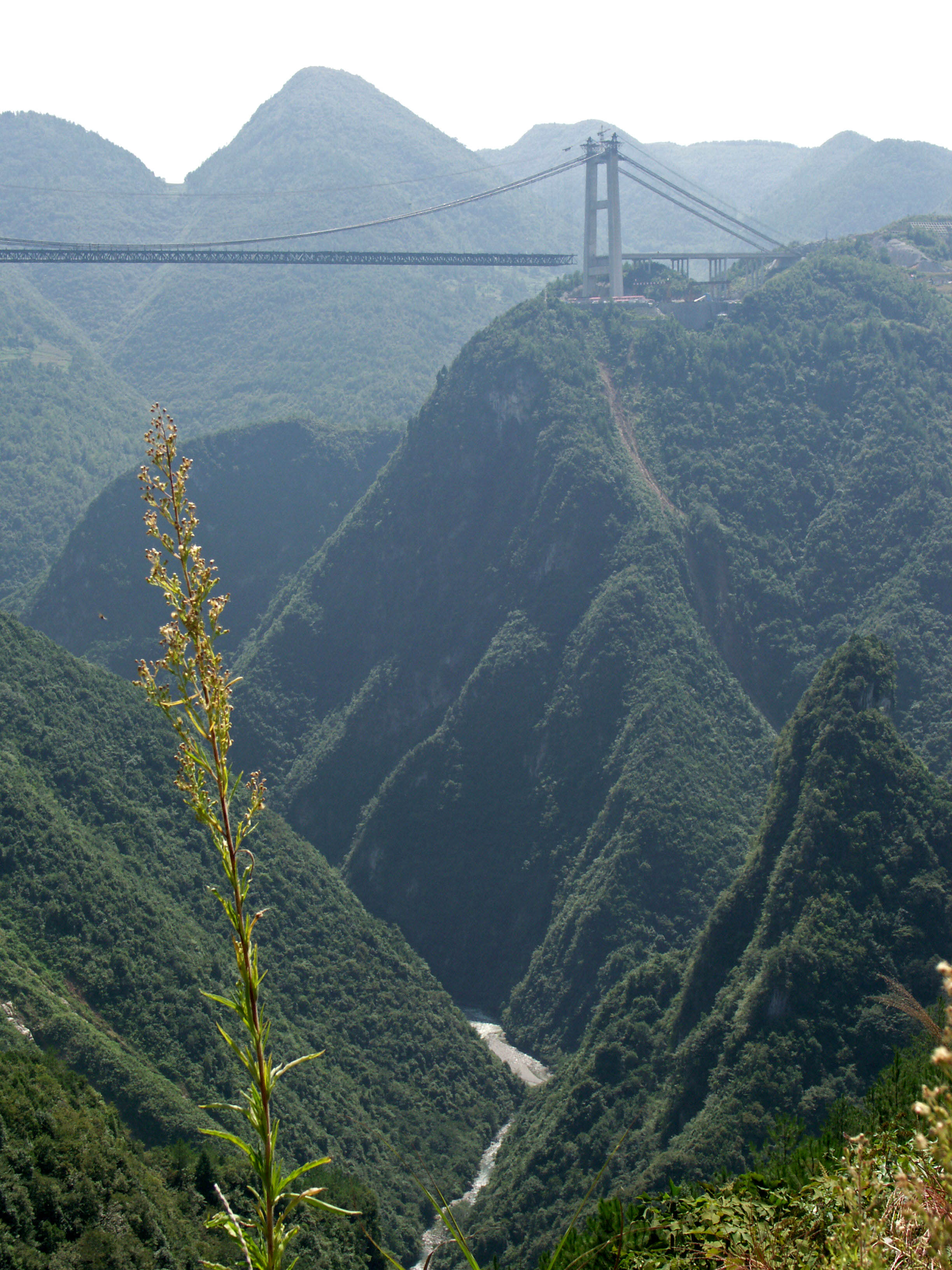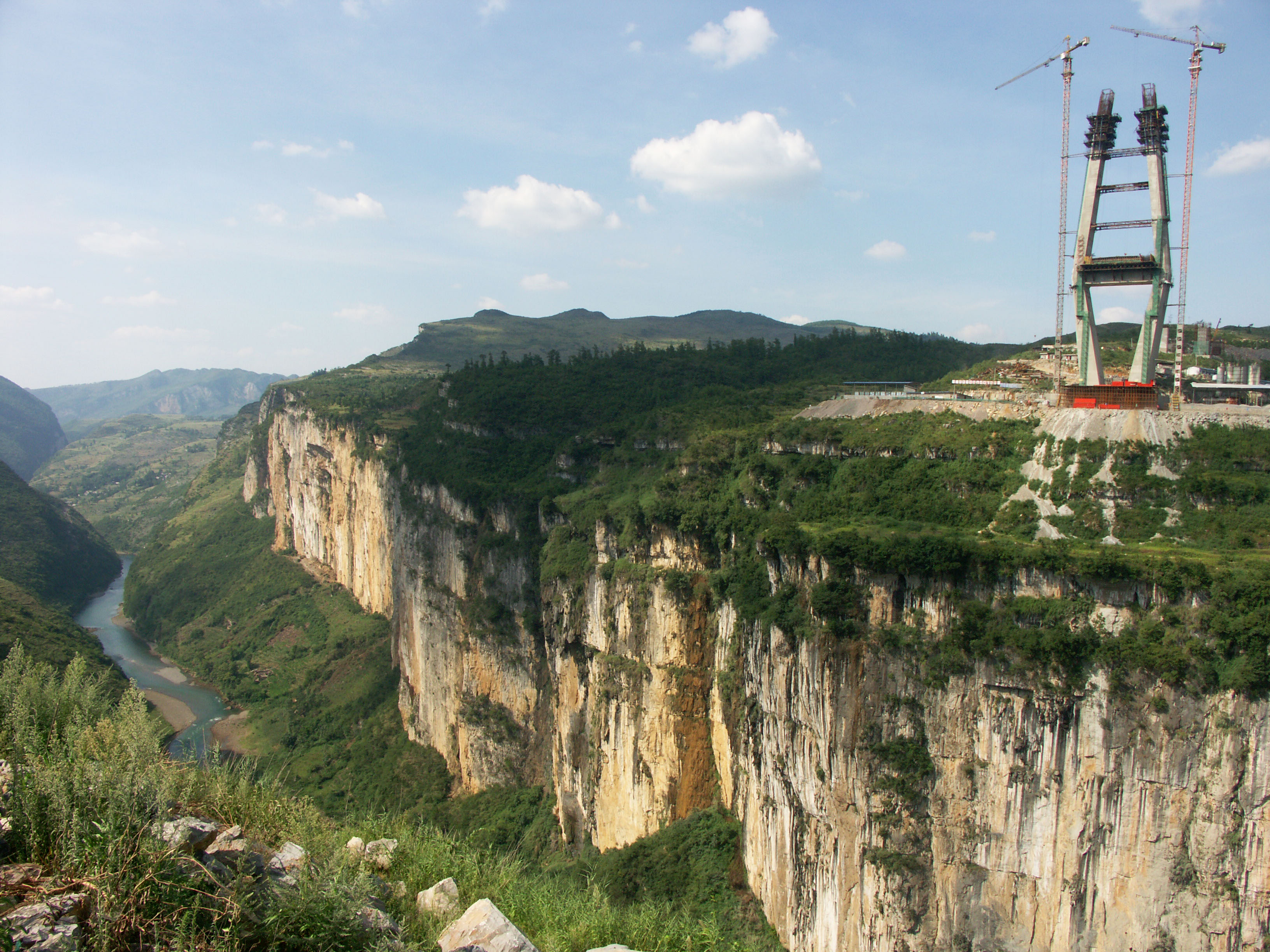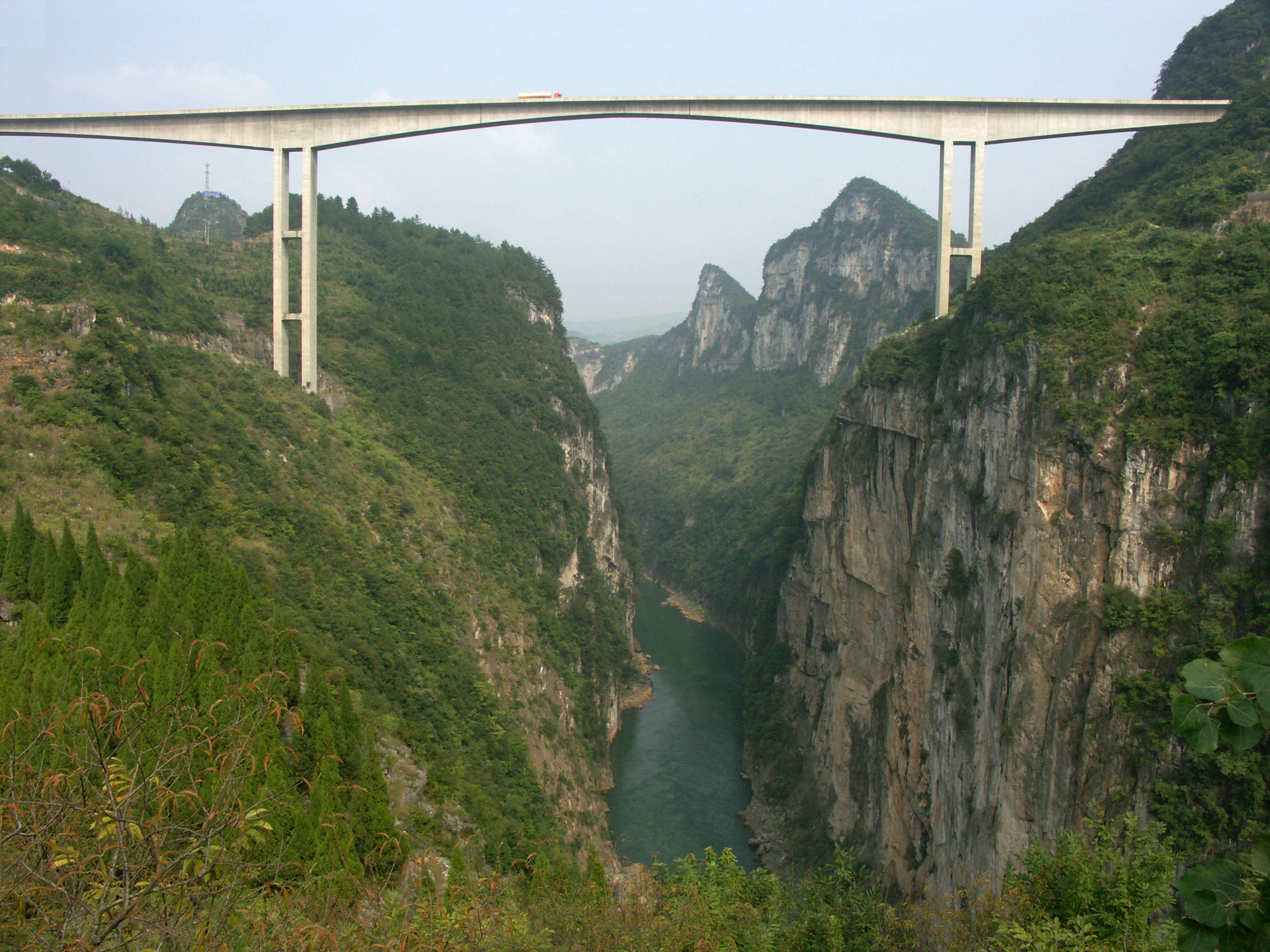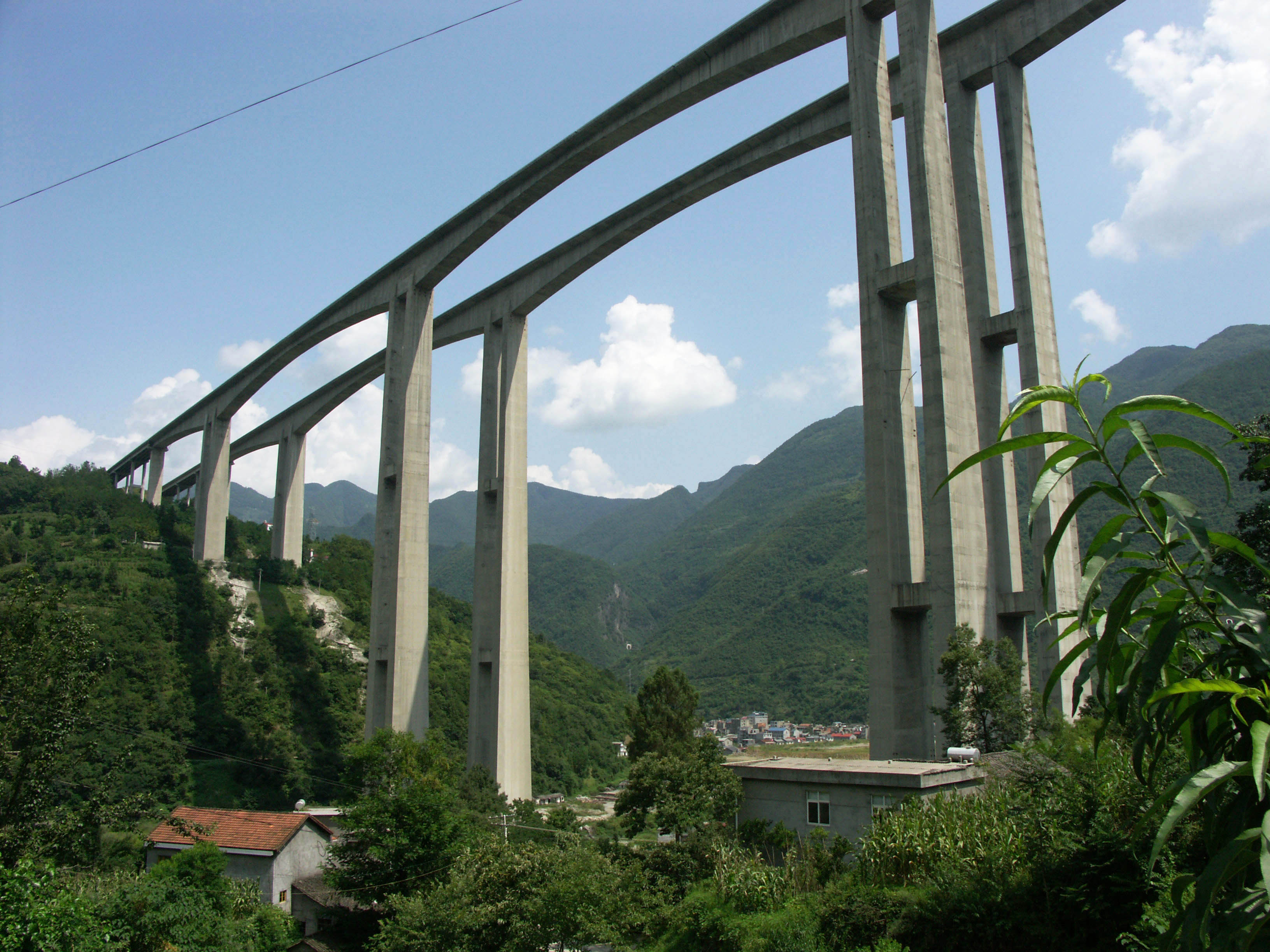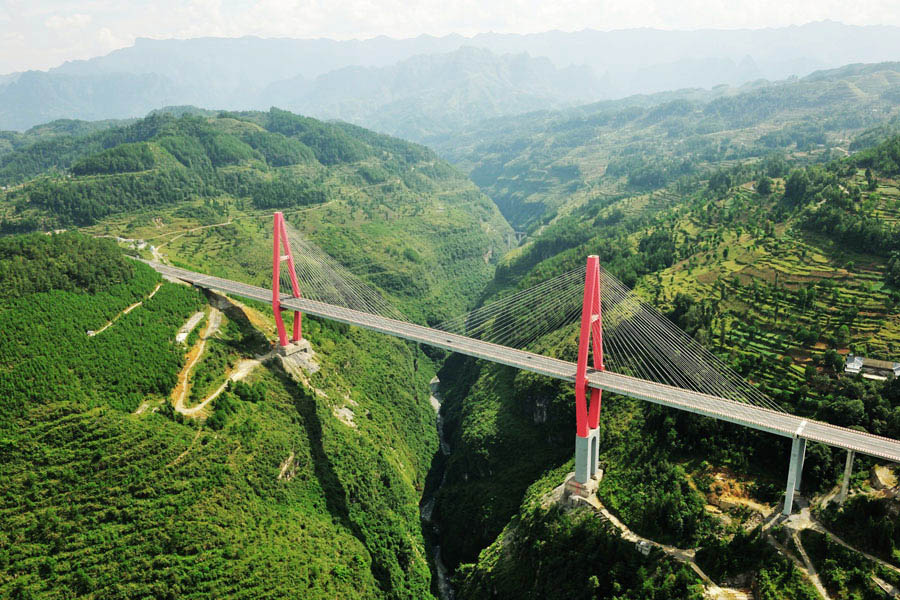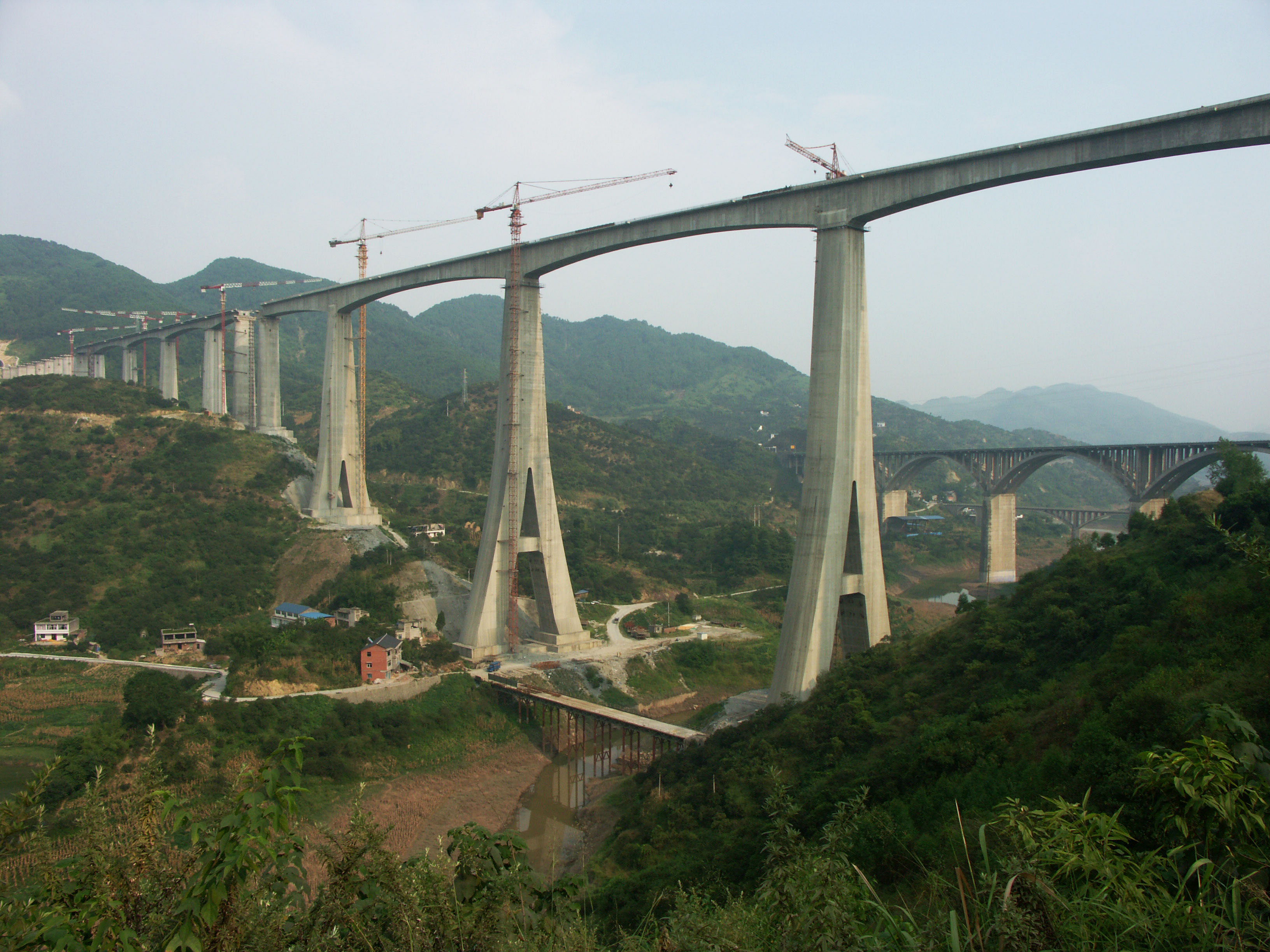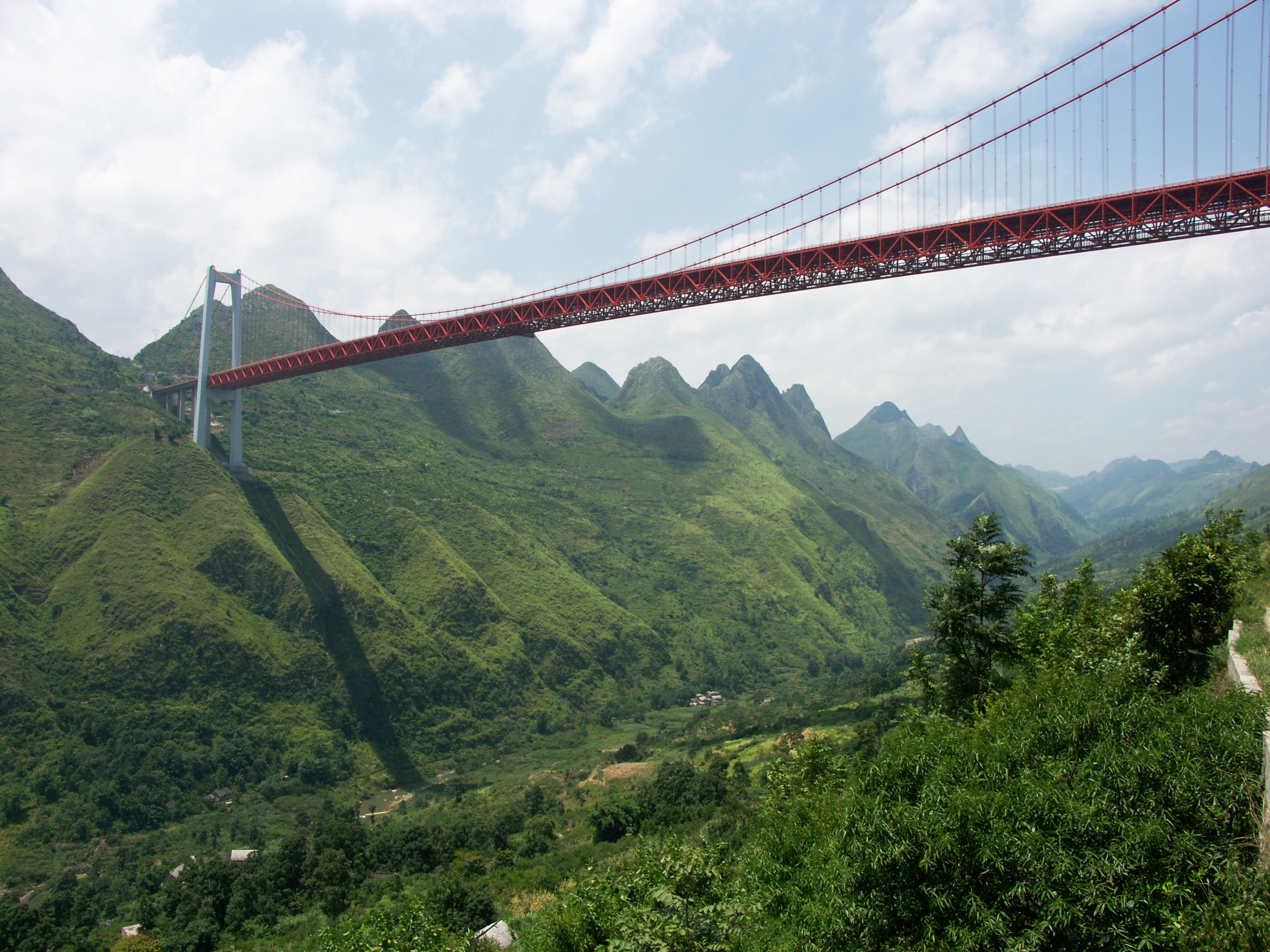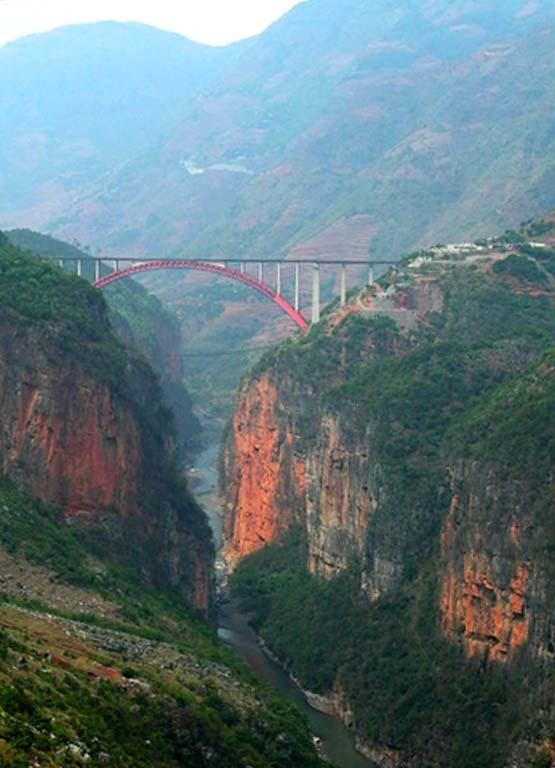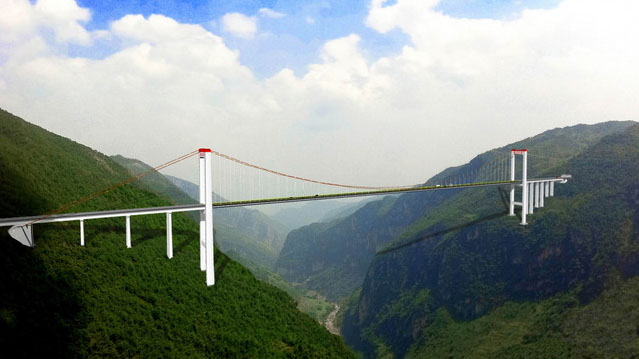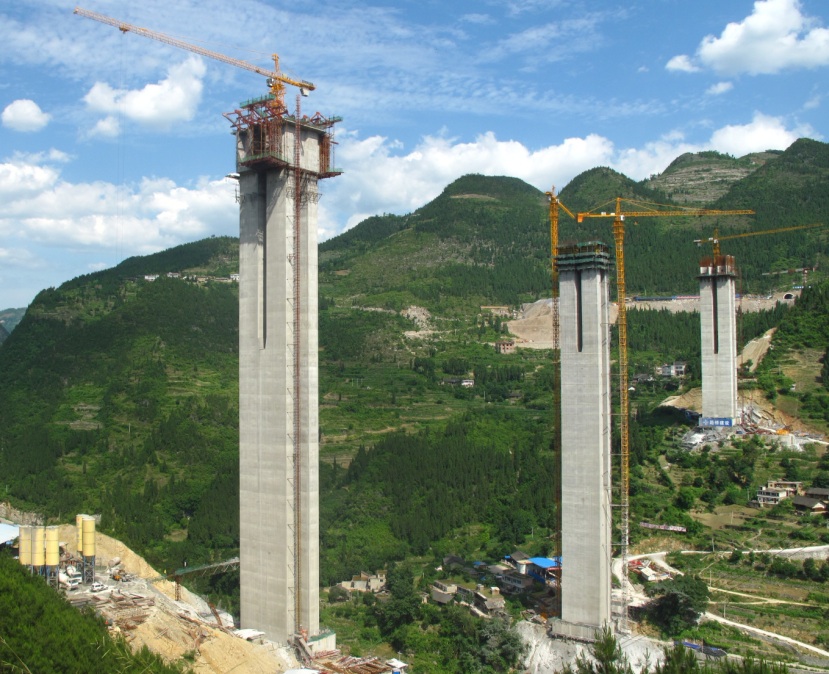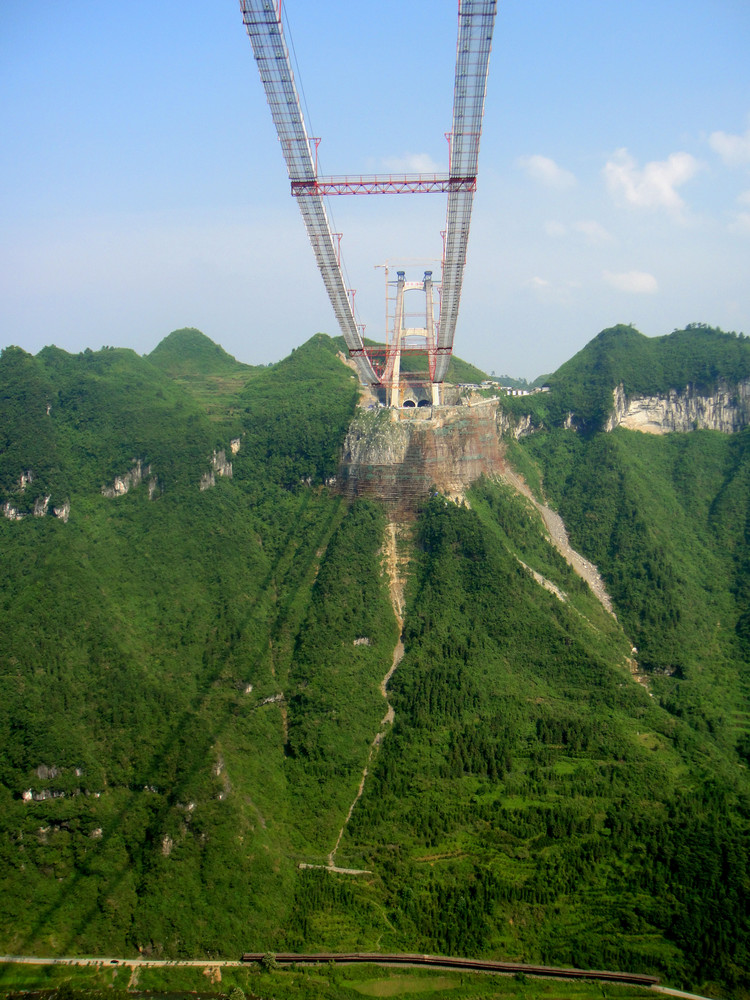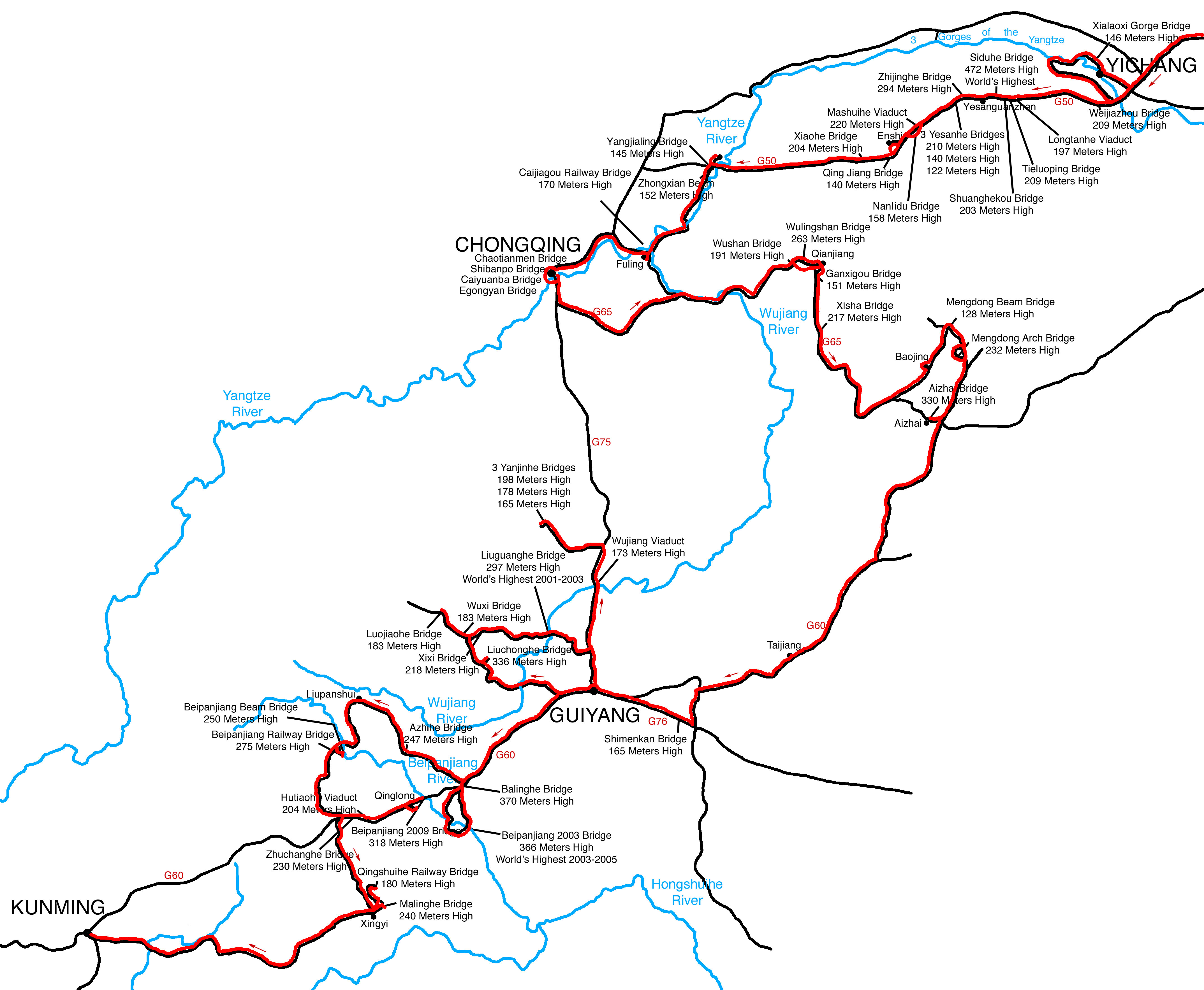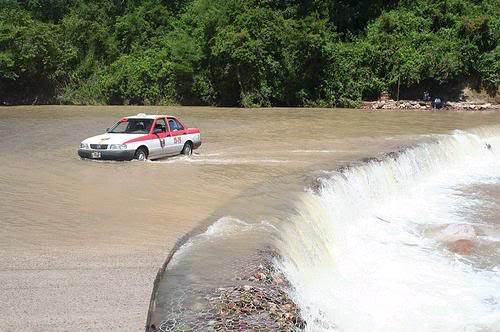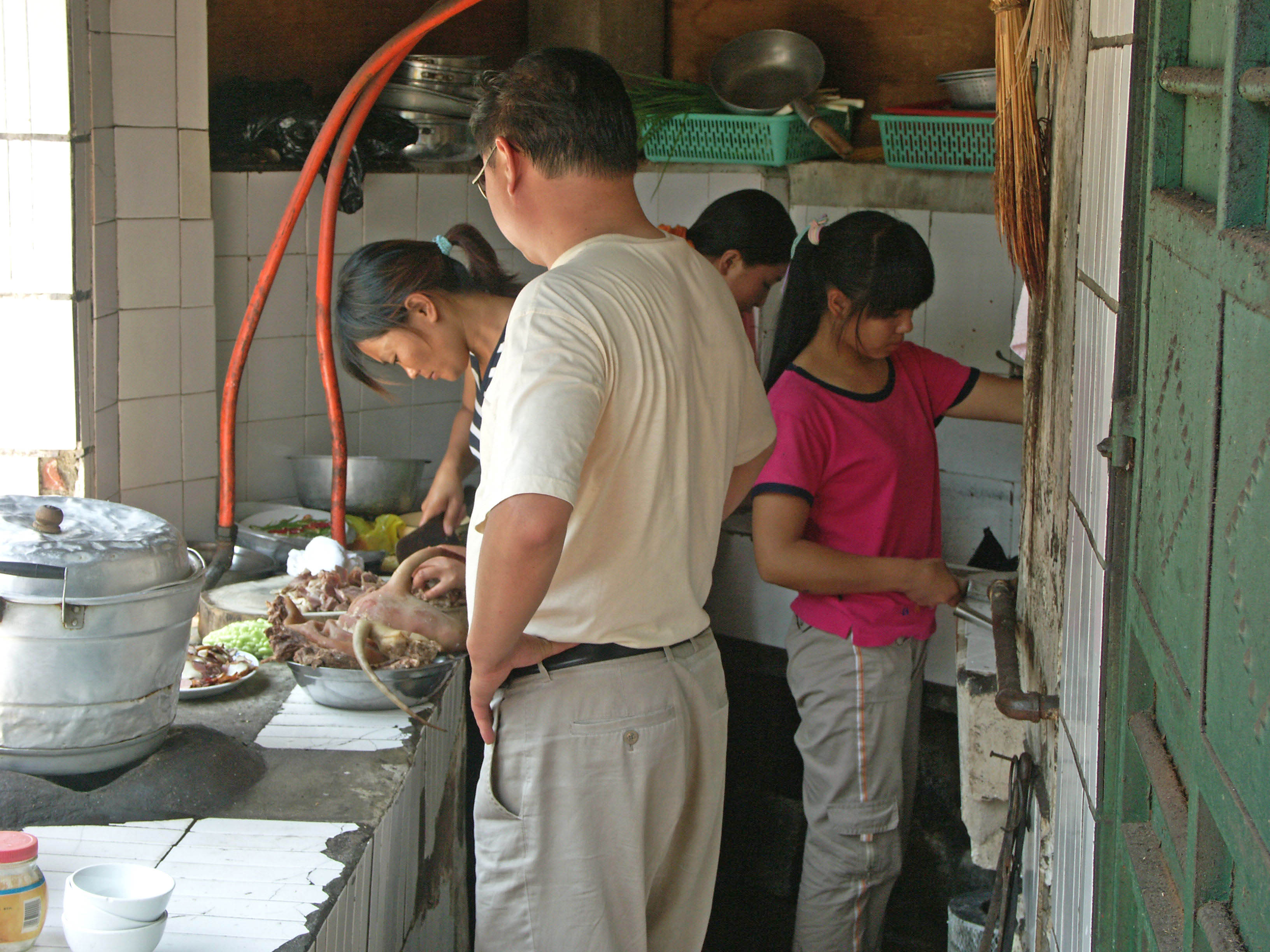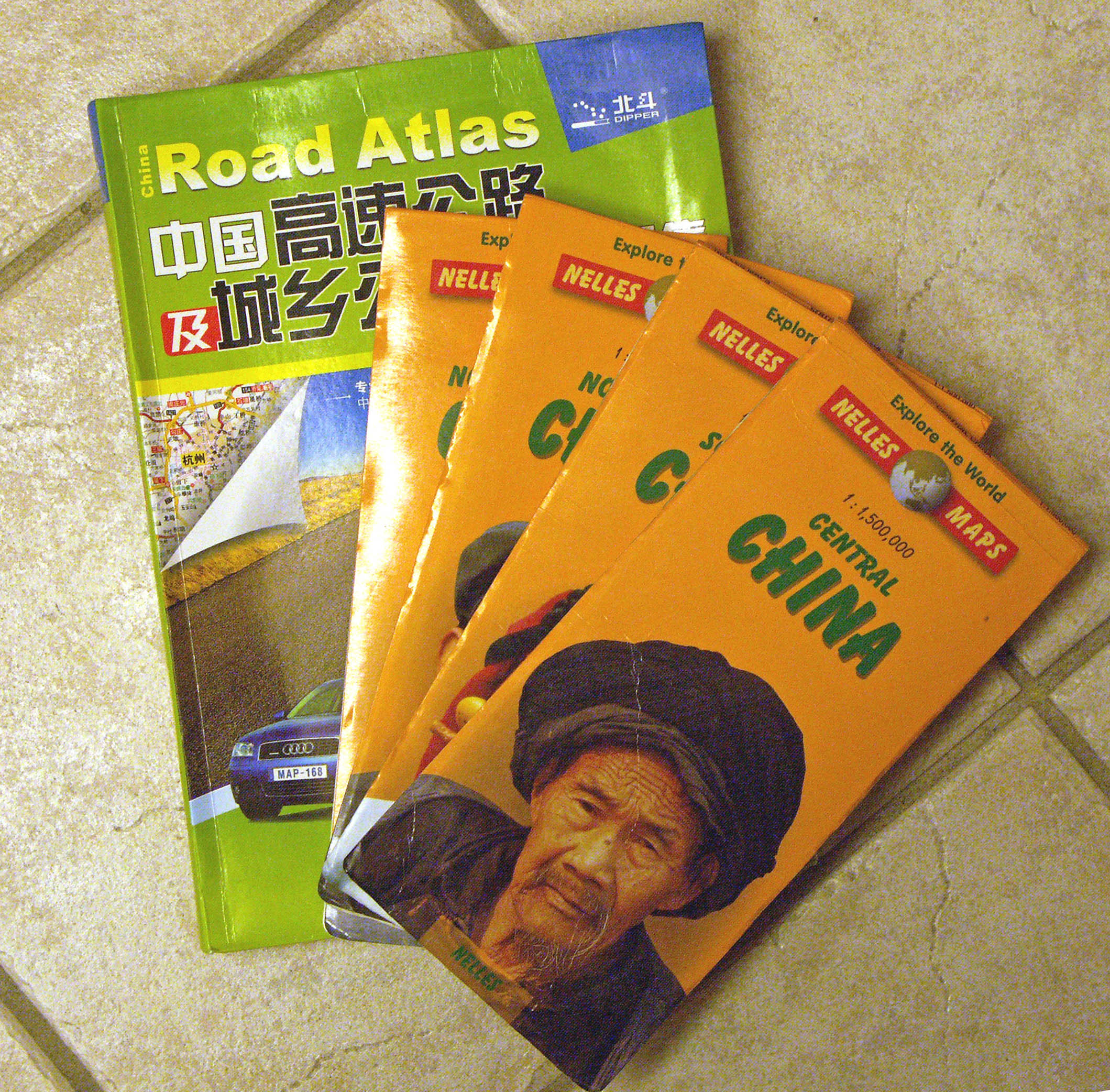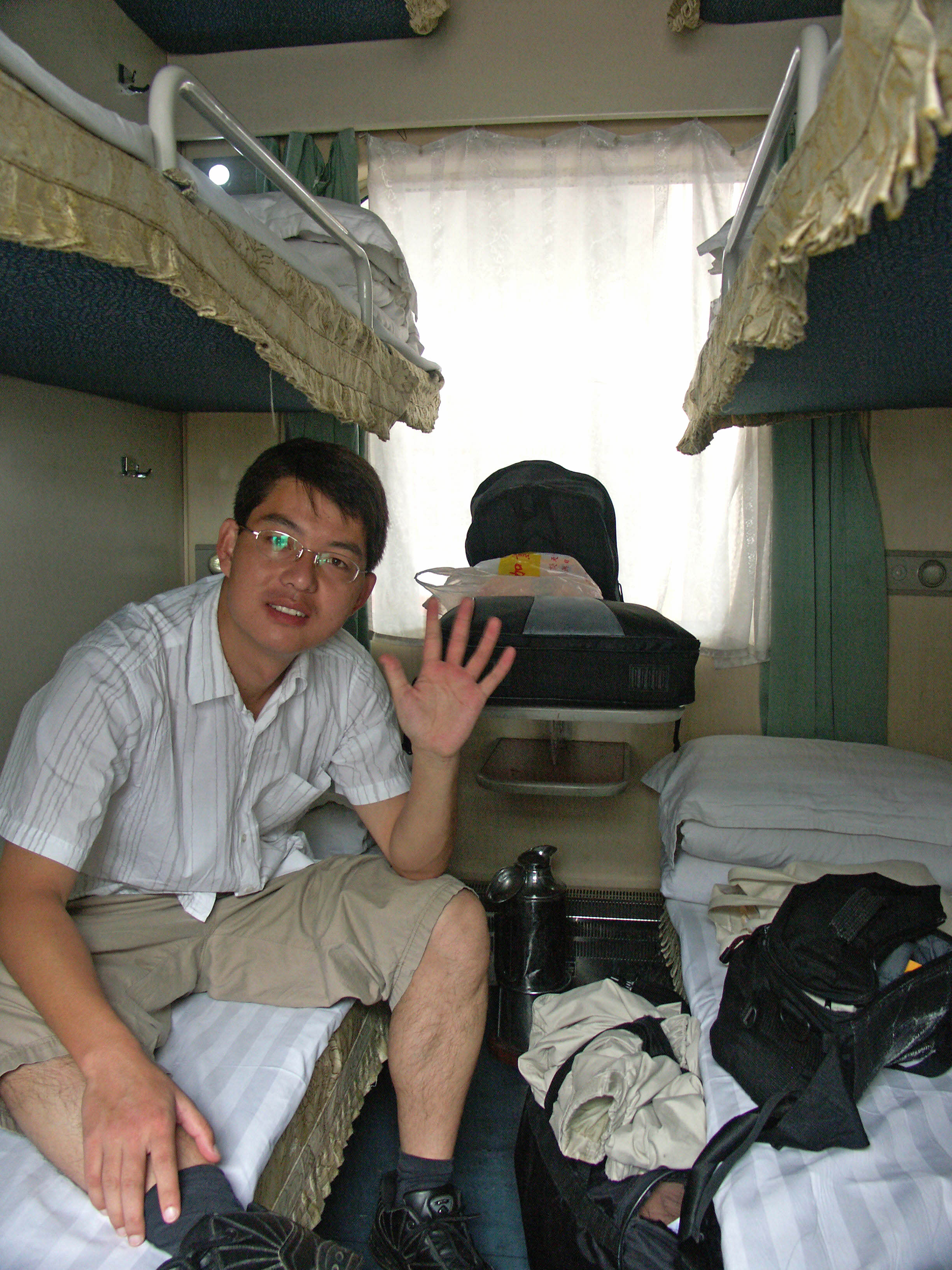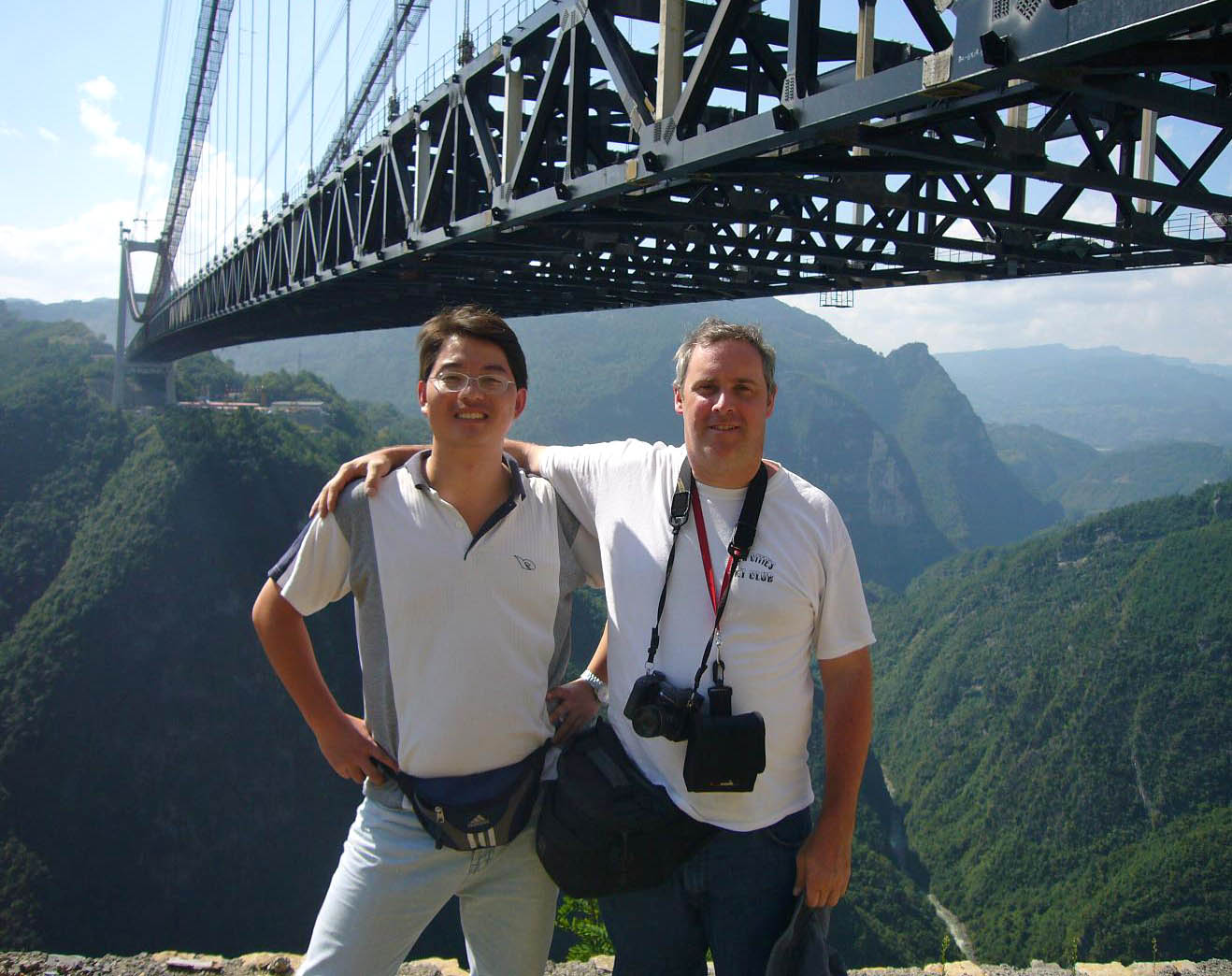Difference between revisions of "China 2013 Bridge Trip"
| (59 intermediate revisions by the same user not shown) | |||
| Line 11: | Line 11: | ||
</div> | </div> | ||
| − | With so many high bridges opening in China I have organized our 3rd annual 3 week “High Over China” bridge trip for the summer of 2013 that will traverse over dozens of incredible new high bridges and expressways including all 12 "Royal Gorge Busters" - bridges that recently toppled the height record of the famous 80-year old bridge in the U.S. state of Colorado and represent 12 of the 13 highest road bridges in the world. | + | With so many high bridges opening in China I have organized our 3rd annual 3 week “High Over China” bridge trip for the summer of 2013 that will traverse over dozens of incredible new high bridges and expressways including all 12 "Royal Gorge Busters" - bridges that recently toppled the height record of the famous 80-year old bridge in the U.S. state of Colorado and represent 12 of the 13 highest road bridges in the world. The trip will only be open to 4 to 6 people as we will be traveling in one high clearance SUV or mini-van. This is no chartered bus trip for a group of 50 people looking to peer out a window to snap a quick photo of a bridge but a gathering of adventurous bridge fanatics who don’t mind a journey off the beaten path. |
This epic bridging tour will include stops to one third of the world’s 100 highest bridges along the brand new Hurong, Jieshuie and Kunming expressways - the #1, #2 and #3 greatest high bridge roadways on earth with the largest collection of skyscraping viaducts and bridges ever assembled. The Hurong and Jieshuie expressways were finally completed in 2010 and also hold the record for more miles of tunnels then any other highways on earth with more then 70 miles located underground on each highway. Only Italy's A20 has as many miles of tunnels. | This epic bridging tour will include stops to one third of the world’s 100 highest bridges along the brand new Hurong, Jieshuie and Kunming expressways - the #1, #2 and #3 greatest high bridge roadways on earth with the largest collection of skyscraping viaducts and bridges ever assembled. The Hurong and Jieshuie expressways were finally completed in 2010 and also hold the record for more miles of tunnels then any other highways on earth with more then 70 miles located underground on each highway. Only Italy's A20 has as many miles of tunnels. | ||
| Line 19: | Line 19: | ||
<div style="text-align: center; font-size: 25px;"> | <div style="text-align: center; font-size: 25px;"> | ||
| − | The World's 12 Highest Bridges | + | The World's 12 Highest Road Bridges in China<br /> |
[[File:RoyalGorgeBusters copy.jpg|950px|center]]<br /> | [[File:RoyalGorgeBusters copy.jpg|950px|center]]<br /> | ||
</div> | </div> | ||
| Line 25: | Line 25: | ||
You will visit more than 50 of the world's highest bridges on this trip<br /> | You will visit more than 50 of the world's highest bridges on this trip<br /> | ||
including 12 of the world's 13 highest road bridges,<br /> | including 12 of the world's 13 highest road bridges,<br /> | ||
| − | a special visit to the secret construction | + | a special visit to the secret construction sites of the world's 2 highest railway bridges,<br /> |
| − | |||
a special visit to the secret construction site of the highest footbridge ever built<br /> | a special visit to the secret construction site of the highest footbridge ever built<br /> | ||
as well as being the longest span Tibet-style footbridge in history,<br /> | as well as being the longest span Tibet-style footbridge in history,<br /> | ||
| Line 47: | Line 46: | ||
• Three meals per day plus snacks & drinks | • Three meals per day plus snacks & drinks | ||
| − | • Visits to at least 10 | + | • Visits to at least 10 major bridge construction sites |
| − | • | + | • Special walk across the highest and longest footbridge in history |
| + | |||
| + | • Special catwalk tour 1,100 feet high within the Aizhai Bridge truss. | ||
• Exclusive 2013 Trip Photo Album posted on this website. | • Exclusive 2013 Trip Photo Album posted on this website. | ||
| Line 60: | Line 61: | ||
| − | = | + | =2013 China Bridge Trip Sampler= |
| − | [[File:47SiduheBridge.jpg| | + | [[File:47SiduheBridge.jpg|300px|left|thumb|Sidhe River Bridge - The highest span on earth]] |
Bridge highlights will begin with visits to Siduhe and Zhijinghe - the highest suspension and arch bridges on earth. Special trips will be taken along construction roads on the north side of both of these spans to allow vantage points not accessible to the public traveling along the highway. We will be getting close up views of Longtanhe and Mashuihe, the highest concrete beam viaducts on earth as well as the 200 meter high monsters Tieluoping, Qing Jiang and Xiaohe. The famous “Yesanhe 5” are also in this region and include the classic arch bridge from 1977 that was once China’s highest at 400 feet as well as the even higher railway and road bridges that were completed in 2009. | Bridge highlights will begin with visits to Siduhe and Zhijinghe - the highest suspension and arch bridges on earth. Special trips will be taken along construction roads on the north side of both of these spans to allow vantage points not accessible to the public traveling along the highway. We will be getting close up views of Longtanhe and Mashuihe, the highest concrete beam viaducts on earth as well as the 200 meter high monsters Tieluoping, Qing Jiang and Xiaohe. The famous “Yesanhe 5” are also in this region and include the classic arch bridge from 1977 that was once China’s highest at 400 feet as well as the even higher railway and road bridges that were completed in 2009. | ||
| − | |||
| − | [[File: | + | Further south will be an excursion along the brand new Jieshui Expressway with several spectacular crossings including Wulingshan - the world’s fourth highest cable stayed bridge after Millau, Baluarte and Liuchonghe with a deck nearly as high as West Virginia’s New River Gorge bridge. At the end of this highway near Jishou will be a visit to what may become the most beautiful suspension bridge in the world - the Aizhai Bridge which connects two mountain ranges that look like they are from a scene from the movie Avatar. Also along this amazing stretch of highway are 5 more 200 meter high monsters - the Ganxigou #2, Yanxigou, Xisha, Furongjiang and Yushan Mountain bridges. |
| + | |||
| + | |||
| + | [[File:AizhaiRednet.cn.jpg|300px|right|thumb|Aizhai Bridge - the Highest in Hunan]] | ||
In the Chongqing region we will see construction progress on the tallest railway bridge supports ever built on the Caijiagou Bridge, a 1.25 mile long monstrosity that will be the largest railway viaduct ever built. In Chongqing city we will visit Chaotianmen, the longest span arch bridge in the world as well as Caiyuanba, the longest combination road and rail arch ever constructed. Also within the “Pittsburgh of China” is Shibanpo, the longest span beam bridge of any kind on the planet. | In the Chongqing region we will see construction progress on the tallest railway bridge supports ever built on the Caijiagou Bridge, a 1.25 mile long monstrosity that will be the largest railway viaduct ever built. In Chongqing city we will visit Chaotianmen, the longest span arch bridge in the world as well as Caiyuanba, the longest combination road and rail arch ever constructed. Also within the “Pittsburgh of China” is Shibanpo, the longest span beam bridge of any kind on the planet. | ||
| − | |||
| − | [[File: | + | [[File:LiuchongheBridge17.jpg|300px|left|thumb|Liuchonghe Bridge - Third Highest Cable Stayed Span]] |
| + | Driving south to Guiyang, the adventure continues into Guizhou Province, a region with more high bridges than any other place on earth. To the east our caravan will venture into the mountains to see the triple crossings of the beautifull Yanjinhe river gorge as well as the gargantuan Wujiang Viaduct and the one-of-a-kind Wujiang cable stayed/suspension bridge. We will continue further north to the colossal Tangxihe beam bridge with a central pier of 175 meters in height. Also along this brand new highway is the Erlanghe Bridge with piers of 166 meters over a canyon more then 600 feet deep. | ||
| + | |||
| + | |||
| + | [[File:1LiuguangheBridge.jpg|300px|right|thumb|Liuguanghe Bridge - World's Highest from 2001-2003]] | ||
| + | Liuguanghe entered the record books in 2001 when it became the world’s highest bridge at 975 feet (297 mtrs), toppling the 72 year old record long held by Colorado’s 955 foot (291 mtr) high Royal Gorge bridge. Even though Liuguanghe’s record would stand for just two years, it will always have the distinction of being the only beam bridge in history that held the top spot among high bridges. Interestingly in 2016 this bridge will lose its status as the world's highest beam bridge to the new Falanggou Bridge which is also located in Guizhou Province. | ||
| + | |||
| + | |||
| + | [[File:Longtanhe2011.jpg|300px|left|thumb|Longtanhe Viaduct - The world's largest beam bridge viaduct]] | ||
| + | There are so many big beam bridges on the Hurong G50 highway but the largest of all is the gargantuan Longtanhe Viaduct with piers as high as a 60-story building supporting several massive beam spans of 200 meters. Also nearby is the beam bridge Shuanghekou with a central pier of 163 meters, the Mashuihe Viaduct with piers of 139 meters and Yesanhe with piers 120 meters high. The Yesanhe River is also crossed by one of the world's higher railway bridges - a beautiful asymmetrical white arch that carries the incredible Yiwan Railway line. We will also be visiting the massive single pier beam bridge railway crossing of the Mashuihe River. This 377 kilometer line between Yichang and Wanzhou is the most difficult stretch of railway line ever constructed with more then 70% of it on bridges or through tunnels. | ||
| + | |||
| + | |||
| + | [[File:WulinghsanByBeiyy.jpg|300px|right|thumb|Wulingshan Bridge - one of the world's highest cable stayed bridges]] | ||
| + | With a deck almost as high as West Virginia's New River Gorge Bridge, the Wulingshan Bridge opened in 2009 as the showpiece bridge along the incredible G65 Chongqing-Hunan Expressway that has a nice selection of high beam bridges as well as a record breaking 70 miles of tunnels. Wulingshan has two planes of stays radiating out in a fan arrangement from a pair of A-frame towers that rise 188 meters from foundation to top. Also nearby we will visit the Yanxigou and Wushan Beam Bridges that cross spectacular gorges more then 500 feet deep near Qianjiang City. | ||
| + | |||
| + | |||
| + | [[File:BeipanjiangByChen7224255.jpg|300px|left|thumb|Beipanjiang 2003 - The world's highest from 2003-2005]] | ||
| + | The highest bridge in the world upon its opening in late 2003, the 1,200 foot (366 mtr) high Beipanjiang River 2003 highway bridge became the second Chinese span in just two years to take this honor. The first was 2001’s Liuguanghe bridge. In addition, the Beipanjiang became the first bridge to break the 1,000 foot and 300 meter height thresholds as well as the first suspension bridge in the world to surpass the height of Colorado’s Royal Gorge bridge after a 74-year reign. The span is unique for having an extremely thin 2 foot (.6 mtr) thick prestressed concrete slab deck and cable suspenders just 16 feet (5 mtrs) apart. While not as high at 247 meters, we will also be visiting the very similarly designed Azhihe Bridge which also has a thin slab deck. | ||
| + | |||
| + | |||
| + | [[File:152CaijiagouRailway2012 copy.jpg|300px|left|thumb|Caijiagou Railway Viaduct - the world's largest railway bridge]] | ||
The next day we set out on the Gui-Bi - one of the world’s 5 greatest high bridge highways. First up will be a visit to Liuguanghe, the world’s highest beam bridge and the first span to topple the 72-year old Royal Gorge bridge height record. Further along towards Bijie are 3 other bridges in the 200 meter height range including Wuxi, Luojiaohe and Xixi bridges. We will be walking across every one of them. | The next day we set out on the Gui-Bi - one of the world’s 5 greatest high bridge highways. First up will be a visit to Liuguanghe, the world’s highest beam bridge and the first span to topple the 72-year old Royal Gorge bridge height record. Further along towards Bijie are 3 other bridges in the 200 meter height range including Wuxi, Luojiaohe and Xixi bridges. We will be walking across every one of them. | ||
| − | |||
| − | |||
| − | + | [[File:Balinghe2011View2.jpg|300px|right|thumb|Balinghe Bridge in Guizhou - The world's 2nd longest span high bridge]] | |
| − | + | Heading west from Guiyang along the new Kunming highway will be a stop to a bridge that will simply take your breath away - the crossing of the Balinghe. Towering 370 meters, this is currently the second highest road bridge on earth after Siduhe. Our high clearance SUV will be going along several dirt roads south of the span to reach some breathtaking vantage points along the Baling River to capture images that would make Ansel Adams proud. | |
| − | + | ||
| − | |||
| − | [[File:BeipanByflili.jpg| | + | [[File:BeipanByflili.jpg|300px|left|thumb|Beipanjiang Railway arch - The world's highest railway bridge]] |
100 miles further north along the Beipanjiang River our convoy will be stopping by the highest railway bridge on earth. The location is so remote there are no known railfans outside of China who have ever visited this jaw-dropping steel arch span. | 100 miles further north along the Beipanjiang River our convoy will be stopping by the highest railway bridge on earth. The location is so remote there are no known railfans outside of China who have ever visited this jaw-dropping steel arch span. | ||
| + | |||
Driving further west on the Kunming highway we will encounter yet another Royal Gorge Buster - the Beipanjiang 2009 highway bridge with a deck more than 1,000 feet high. Like a gift that keeps on giving, the Kunming highway will be offering up more goodies as we continue west with a triad of massive viaducts perched on piers as high as 150 meters. They include the Mengzhai, Baishuichong and Hutiaohe Viaducts. | Driving further west on the Kunming highway we will encounter yet another Royal Gorge Buster - the Beipanjiang 2009 highway bridge with a deck more than 1,000 feet high. Like a gift that keeps on giving, the Kunming highway will be offering up more goodies as we continue west with a triad of massive viaducts perched on piers as high as 150 meters. They include the Mengzhai, Baishuichong and Hutiaohe Viaducts. | ||
| − | |||
| − | |||
| − | + | [[File:PuliComputerView.jpg|300px|right|thumb|Puli Bridge - The world's highest thin deck suspension span]] | |
| + | The fun continues with a stop at the construction site of the world's highest thin deck suspension bridge over the Puli Gorge. The group will then head south on the smooth new 4-lane highway to visit the incredible Beipanjiang 2012 Bridge with a monstrous beam span of 290 meters as well as the nearby Railway bridge that will be the highest of its type before being surpassed in 2015 by an even higher Chinese arch. | ||
| + | |||
| + | |||
| + | [[File:SecretTibetDrawing.jpg|300px|left|thumb|Actual canyon site with the world's highest and longest Tibet-style footbridge drawn in]] | ||
| + | Our adventure will reach new heights as we become the only non-Chinese people in history to venture across the highest and longest footbridge span ever built. With an anchorage to anchorage distance greater then the Brooklyn Bridge, this narrow feat of engineering is sure to induce vertigo into those with weak knees. Our movement across such a huge span is sure to create some unusual oscillations and sustained "wave" motions that have never been experienced on a bridge before. At over 900 feet in height, this shaky, chicken wire deck will be more then 5 times as high as the famous Capilano Bridge! | ||
| + | |||
| − | [[File: | + | [[File:ZhijingheArchWideView.jpg|300px|right|thumb|Zhijinghe - The highest arch bridge in the world]] |
| − | We will be visiting the | + | We will be visiting the 2 Hunan beauties in the form of Aizhai and Lishuihe suspension bridges which rise more then 330 meters above their respective gorges in the famous Zhangjiajie region of China which inspired the look of the movie Avatar. |
| − | |||
| − | |||
| − | + | [[File:TongziPiers.jpg|300px|left|thumb|Tongzihe Bridge with one of the 10 highest piers on earth]] | |
| + | Monster viaducts don't come much bigger then Tongzihe, another high Chinese crossing of gargantuan proportions, the Tongzihe Bridge is the largest structure on the extension of the Zunchi Expressway that continues north from Renhuai city to the Guizhou/Sichuan border where the bridge is located at kilometer 50. The central piers measures 575 feet and is one of the world's 10 tallest bridge piers. | ||
| − | + | ||
| + | The three main piers of Tongzihe are solid at the base and support both directions of highway. The tallest measures a jaw dropping 175 meters from foundation to cap and ranks among the 10 tallest on earth. | ||
| + | |||
| + | |||
| + | Finally we will venture to the secret construction sites of the two highest railway bridge crossings that have ever been undertaken in the world of bridges with decks higher then the Hoover Dam Bypass Bridge with room to spare. One of these bridges will also have a main span that will also break records for its length. | ||
| − | Feel free to contact me with any questions you may have at Eric@HighestBridges.com. The price of this 3-week trip is under | + | [[File:World'sHighestRailway.jpg|447px|right|thumb|The highest railway bridge on earth rises more then 900 feet above one of Western China's deepest river gorges]] |
| + | |||
| + | Once the organized 3 week trip is over, I will be traveling for another week to visit more obscure high bridges. Anyone would be welcome to continue on with me, splitting travel expenses evenly. | ||
| + | |||
| + | |||
| + | A total of 2 to 4 people will be on the trip plus myself, an interpreter and a driver. As trip planners and organizers, we will be taking care of everything for the 2 to 4 additional guests. This includes the round trip air fare from Shanghai to Western China as well as the hotels, meals and car travel. We are hoping to pair single people together in hotel rooms but if you don’t mind the additional cost you can have your own private room for the duration of the trip. With each spot being filled on a first-come, first-served basis, you might be out of luck if you wait too long! | ||
| + | |||
| + | |||
| + | This trip is not for the timid or physically challenged. We will be traveling down into the canyons beneath these bridges on dirt roads that are often bumpy, dusty and uncomfortable. There will be short but occasionally strenuous hikes down paths to reach spectacular viewpoints. At the end of the day you will be sweaty, dirty and wanting nothing more than a hot meal, a hot shower and a cool hotel room to sleep in. | ||
| + | |||
| + | |||
| + | Feel free to contact me with any questions you may have at Eric@HighestBridges.com. The price of this 3-week trip is under 5,000 dollars which is an incredible bargain, so don't be shy about contacting me. This trip can only happen if at least 4 people sign up! | ||
=List of 50 Highest Bridges on the Tour= | =List of 50 Highest Bridges on the Tour= | ||
| − | [[File:AizhaiAwesome.jpg|550px|right|thumb|Aizhai Bridge | + | [[File:AizhaiAwesome.jpg|550px|right|thumb|Aizhai Bridge under construction]] |
* [[Siduhe River Bridge]] | * [[Siduhe River Bridge]] | ||
| Line 118: | Line 156: | ||
* [[Yesanhe River Railway Bridge]] | * [[Yesanhe River Railway Bridge]] | ||
* [[Mashuihe River Viaduct]] | * [[Mashuihe River Viaduct]] | ||
| − | * [[ | + | * [[Mashuihe River Railway Bridge]] |
| − | * [[ | + | * [[Yexihe Railway Bridge]] |
| − | |||
* [[Xiaohe River Bridge]] | * [[Xiaohe River Bridge]] | ||
* [[Caijiagou Railway Viaduct]] | * [[Caijiagou Railway Viaduct]] | ||
| − | * [[ | + | * [[Wujiang River Viaduct Sinan]] |
| + | * [[Wujiang River Viaduct Sinan]] | ||
* [[Yanxigou Bridge]] | * [[Yanxigou Bridge]] | ||
* [[Wulingshan Bridge]] | * [[Wulingshan Bridge]] | ||
* [[Ganxigou Bridge No. 2]] | * [[Ganxigou Bridge No. 2]] | ||
| − | |||
* [[Xisha Bridge]] | * [[Xisha Bridge]] | ||
| − | * [[ | + | * [[Tongzihe Bridge]] |
* [[Aizhai Bridge]] | * [[Aizhai Bridge]] | ||
| − | * [[Secret Bridge # | + | * [[Lishuihe River Bridge]] |
| − | * [[ | + | * [[Secret Railway Bridge #1]] |
| + | * [[Secret Footbridge #1]] | ||
| + | * [[Liuchonghe Bridge]] | ||
* [[Yanjinhe River 2009 Bridge]] | * [[Yanjinhe River 2009 Bridge]] | ||
* [[Yanjinhe River 1995 Bridge]] | * [[Yanjinhe River 1995 Bridge]] | ||
| Line 140: | Line 179: | ||
* [[Xixi Bridge]] | * [[Xixi Bridge]] | ||
* [[Wuxi Bridge]] | * [[Wuxi Bridge]] | ||
| − | * [[ | + | * [[Dimuhe River Bridge]] |
* [[Xixi Gangou Bridge]] | * [[Xixi Gangou Bridge]] | ||
| − | |||
* [[Balinghe River Bridge]] | * [[Balinghe River Bridge]] | ||
* [[Azhihe River Bridge]] | * [[Azhihe River Bridge]] | ||
| + | * [[Puli Bridge]] | ||
* [[Beipanjiang River Railway Bridge]] | * [[Beipanjiang River Railway Bridge]] | ||
* [[Beipanjiang River 2003 Bridge]] | * [[Beipanjiang River 2003 Bridge]] | ||
| + | * [[Beipanjiang River 2012 Bridge]] | ||
| + | * [[Mengdong River Bridge]] | ||
* [[Kunming Highway Beam Bridge]] | * [[Kunming Highway Beam Bridge]] | ||
* [[Kunming Highway Arch Bridge]] | * [[Kunming Highway Arch Bridge]] | ||
* [[Beipanjiang River 2009 Bridge]] | * [[Beipanjiang River 2009 Bridge]] | ||
* [[Beipanjiang River 2012 Bridge]] | * [[Beipanjiang River 2012 Bridge]] | ||
| − | |||
| − | |||
* [[Hutiaohe River Viaduct]] | * [[Hutiaohe River Viaduct]] | ||
* [[Zhuchanghe River Bridge]] | * [[Zhuchanghe River Bridge]] | ||
| − | |||
| − | |||
| − | |||
| − | =Looking To Create Your Own | + | |
| + | [[File:China2011TripMap.jpg|500px|left|thumb|Planned Route of China 2013 High Bridge Trip Route]] | ||
| + | |||
| + | =Looking To Create Your Own High Bridge Trip?= | ||
| − | Regardless of whether you want to be a part of my bridge tour or head off to Western China on your own, you need to understand up front that you cannot drive to these high bridges yourself. Since you must hire your own guide and/or driver, the following travel advice is for anyone who might be thinking about planning their own high bridge trip through Western China. Much of this advice also applies to those who might be coming on my | + | Regardless of whether you want to be a part of my bridge tour or head off to Western China on your own, you need to understand up front that you cannot drive to these high bridges yourself. Since you must hire your own guide and/or driver, the following travel advice is for anyone who might be thinking about planning their own high bridge trip through Western China. Much of this advice also applies to those who might be coming on my 2013 trip. |
[[File:TaxiRiver.jpg|200px|left|thumb|Make sure your taxi driver does not mind going "off-road"]] | [[File:TaxiRiver.jpg|200px|left|thumb|Make sure your taxi driver does not mind going "off-road"]] | ||
| Line 205: | Line 244: | ||
= Additional Bridge Information = | = Additional Bridge Information = | ||
* [[10 Great Bridge Books and Web Sites]] | * [[10 Great Bridge Books and Web Sites]] | ||
| − | * [[ | + | * [[2011 High Bridge Trip Photo Album]] |
| − | * [[ | + | * [[2012 High Bridge Trip Photo Album]] |
| − | + | * [[2013 High Bridge Trip Photo Album]] | |
| − | |||
| − | |||
| − | |||
| − | |||
| − | |||
| − | |||
| − | |||
| − | |||
| − | |||
| − | |||
| − | |||
| − | |||
| − | |||
| − | |||
| − | |||
| − | |||
| − | |||
| − | |||
| − | |||
| − | |||
| − | |||
| − | |||
| − | |||
| − | |||
| − | |||
| − | |||
| − | |||
| − | |||
| − | |||
| − | |||
| − | |||
| − | |||
| − | |||
| − | |||
| − | |||
| − | |||
| − | |||
| − | |||
| − | |||
| − | |||
| − | |||
| − | |||
| − | |||
| − | |||
| − | |||
| − | |||
| − | |||
| − | |||
| − | |||
| − | |||
| − | |||
| − | |||
| − | |||
| − | |||
| − | |||
| − | |||
| − | |||
| − | |||
| − | |||
| − | |||
| − | |||
| − | |||
| − | |||
| − | |||
| − | |||
| − | |||
| − | [[ | ||
| − | |||
| − | |||
| − | |||
| − | |||
| − | |||
| − | |||
| − | |||
| − | |||
| − | |||
| − | |||
| − | |||
| − | |||
| − | |||
| − | |||
| − | |||
| − | |||
| − | |||
| − | |||
| − | |||
| − | |||
| − | |||
| − | |||
| − | |||
| − | |||
| − | |||
| − | |||
| − | |||
| − | |||
| − | |||
| − | |||
| − | |||
| − | |||
| − | |||
| − | |||
| − | |||
| − | |||
| − | |||
| − | |||
| − | |||
| − | |||
| − | |||
| − | |||
| − | |||
| − | |||
| − | |||
| − | |||
| − | |||
| − | |||
| − | |||
| − | |||
| − | |||
| − | |||
| − | |||
| − | |||
| − | |||
| − | |||
| − | |||
| − | |||
| − | |||
| − | |||
| − | |||
| − | |||
| − | |||
| − | |||
| − | |||
| − | |||
| − | |||
| − | |||
| − | |||
| − | |||
| − | |||
| − | |||
| − | |||
| − | |||
| − | |||
| − | |||
| − | |||
| − | |||
| − | |||
| − | |||
| − | |||
| − | |||
| − | |||
| − | |||
| − | |||
| − | |||
| − | |||
| − | |||
| − | |||
| − | |||
| − | |||
| − | |||
| − | |||
| − | |||
| − | |||
| − | |||
| − | |||
| − | |||
| − | |||
| − | |||
| − | |||
| − | |||
| − | |||
| − | |||
| − | |||
| − | |||
| − | |||
| − | |||
| − | |||
| − | |||
| − | |||
| − | |||
| − | |||
| − | |||
| − | |||
| − | |||
| − | |||
| − | |||
| − | |||
| − | |||
| − | |||
| − | |||
| − | |||
| − | |||
| − | |||
| − | |||
| − | |||
| − | |||
| − | |||
| − | |||
| − | |||
| − | |||
| − | |||
| − | |||
| − | |||
| − | |||
| − | |||
| − | |||
| − | |||
| − | |||
| − | |||
| − | |||
| − | |||
| − | |||
| − | |||
| − | |||
| − | |||
| − | |||
| − | |||
| − | |||
| − | |||
| − | |||
| − | |||
| − | |||
| − | |||
| − | |||
| − | |||
| − | |||
| − | |||
| − | |||
| − | |||
| − | |||
| − | |||
| − | |||
| − | |||
| − | |||
| − | |||
| − | |||
| − | |||
| − | |||
| − | |||
| − | |||
| − | |||
| − | |||
| − | |||
| − | |||
| − | |||
| − | |||
| − | |||
| − | |||
| − | |||
| − | |||
| − | |||
| − | |||
| − | |||
| − | |||
| − | |||
| − | |||
| − | |||
| − | |||
| − | |||
| − | |||
| − | |||
| − | |||
| − | |||
| − | |||
| − | |||
| − | |||
| − | |||
| − | |||
| − | |||
| − | |||
| − | |||
| − | |||
| − | |||
| − | |||
| − | |||
| − | |||
| − | |||
| − | |||
| − | |||
| − | |||
| − | |||
| − | |||
| − | |||
| − | |||
| − | |||
| − | |||
| − | |||
| − | |||
| − | |||
| − | |||
| − | |||
| − | |||
| − | |||
| − | |||
| − | |||
| − | |||
| − | |||
Latest revision as of 02:46, 28 November 2013
Come Along On Our 3rd Annual Bridge Trip To China
August 3rd - August 24, 2013
With so many high bridges opening in China I have organized our 3rd annual 3 week “High Over China” bridge trip for the summer of 2013 that will traverse over dozens of incredible new high bridges and expressways including all 12 "Royal Gorge Busters" - bridges that recently toppled the height record of the famous 80-year old bridge in the U.S. state of Colorado and represent 12 of the 13 highest road bridges in the world. The trip will only be open to 4 to 6 people as we will be traveling in one high clearance SUV or mini-van. This is no chartered bus trip for a group of 50 people looking to peer out a window to snap a quick photo of a bridge but a gathering of adventurous bridge fanatics who don’t mind a journey off the beaten path.
This epic bridging tour will include stops to one third of the world’s 100 highest bridges along the brand new Hurong, Jieshuie and Kunming expressways - the #1, #2 and #3 greatest high bridge roadways on earth with the largest collection of skyscraping viaducts and bridges ever assembled. The Hurong and Jieshuie expressways were finally completed in 2010 and also hold the record for more miles of tunnels then any other highways on earth with more then 70 miles located underground on each highway. Only Italy's A20 has as many miles of tunnels.
Our 3rd annual bridge trip will follow the pattern set with the 2011 High Bridge Trip with a small group of bridge fans meeting in Shanghai before flying to Wuhan deep in western China where our trip will begin with our personal driver, mini-van and interpreter. Our driver will be dropping us off in the center or at one end of each bridge where we will hike across the span on pedestrian walkways or in the safety lane as well as trekking underneath the deck and just about anywhere else we can legally go to get that perfect photo. Expect to smell, touch and feel these bridges in a way you could never do in Europe or the U.S. Prepare for some dust, dirt and a lot of sweat.
You will visit more than 50 of the world's highest bridges on this trip
including 12 of the world's 13 highest road bridges,
a special visit to the secret construction sites of the world's 2 highest railway bridges,
a special visit to the secret construction site of the highest footbridge ever built
as well as being the longest span Tibet-style footbridge in history,
the world's 2 largest railway viaducts
and so much more!
The third ever HighestBridges.com Organized Bridge Trip to China includes:
• All Ground Transportation via one 6 or 8-seat SUV for 3 full weeks
• 22 Nights of Lodging from Friday Night 8/2 through Friday Night 8/23
• Flight from Shanghai to Wuhan in Western China.
• Three meals per day plus snacks & drinks
• Visits to at least 10 major bridge construction sites
• Special walk across the highest and longest footbridge in history
• Special catwalk tour 1,100 feet high within the Aizhai Bridge truss.
• Exclusive 2013 Trip Photo Album posted on this website.
• View the 2011 Trip Photo Album at: http://highestbridges.com/wiki/index.php?title=2011_High_Bridge_Trip_Photo_Album
• View the 2012 Trip Photo Album at: http://highestbridges.com/wiki/index.php?title=2012_High_Bridge_Trip_Photo_Album
• All for just $4,450!
2013 China Bridge Trip Sampler
Bridge highlights will begin with visits to Siduhe and Zhijinghe - the highest suspension and arch bridges on earth. Special trips will be taken along construction roads on the north side of both of these spans to allow vantage points not accessible to the public traveling along the highway. We will be getting close up views of Longtanhe and Mashuihe, the highest concrete beam viaducts on earth as well as the 200 meter high monsters Tieluoping, Qing Jiang and Xiaohe. The famous “Yesanhe 5” are also in this region and include the classic arch bridge from 1977 that was once China’s highest at 400 feet as well as the even higher railway and road bridges that were completed in 2009.
Further south will be an excursion along the brand new Jieshui Expressway with several spectacular crossings including Wulingshan - the world’s fourth highest cable stayed bridge after Millau, Baluarte and Liuchonghe with a deck nearly as high as West Virginia’s New River Gorge bridge. At the end of this highway near Jishou will be a visit to what may become the most beautiful suspension bridge in the world - the Aizhai Bridge which connects two mountain ranges that look like they are from a scene from the movie Avatar. Also along this amazing stretch of highway are 5 more 200 meter high monsters - the Ganxigou #2, Yanxigou, Xisha, Furongjiang and Yushan Mountain bridges.
In the Chongqing region we will see construction progress on the tallest railway bridge supports ever built on the Caijiagou Bridge, a 1.25 mile long monstrosity that will be the largest railway viaduct ever built. In Chongqing city we will visit Chaotianmen, the longest span arch bridge in the world as well as Caiyuanba, the longest combination road and rail arch ever constructed. Also within the “Pittsburgh of China” is Shibanpo, the longest span beam bridge of any kind on the planet.
Driving south to Guiyang, the adventure continues into Guizhou Province, a region with more high bridges than any other place on earth. To the east our caravan will venture into the mountains to see the triple crossings of the beautifull Yanjinhe river gorge as well as the gargantuan Wujiang Viaduct and the one-of-a-kind Wujiang cable stayed/suspension bridge. We will continue further north to the colossal Tangxihe beam bridge with a central pier of 175 meters in height. Also along this brand new highway is the Erlanghe Bridge with piers of 166 meters over a canyon more then 600 feet deep.
Liuguanghe entered the record books in 2001 when it became the world’s highest bridge at 975 feet (297 mtrs), toppling the 72 year old record long held by Colorado’s 955 foot (291 mtr) high Royal Gorge bridge. Even though Liuguanghe’s record would stand for just two years, it will always have the distinction of being the only beam bridge in history that held the top spot among high bridges. Interestingly in 2016 this bridge will lose its status as the world's highest beam bridge to the new Falanggou Bridge which is also located in Guizhou Province.
There are so many big beam bridges on the Hurong G50 highway but the largest of all is the gargantuan Longtanhe Viaduct with piers as high as a 60-story building supporting several massive beam spans of 200 meters. Also nearby is the beam bridge Shuanghekou with a central pier of 163 meters, the Mashuihe Viaduct with piers of 139 meters and Yesanhe with piers 120 meters high. The Yesanhe River is also crossed by one of the world's higher railway bridges - a beautiful asymmetrical white arch that carries the incredible Yiwan Railway line. We will also be visiting the massive single pier beam bridge railway crossing of the Mashuihe River. This 377 kilometer line between Yichang and Wanzhou is the most difficult stretch of railway line ever constructed with more then 70% of it on bridges or through tunnels.
With a deck almost as high as West Virginia's New River Gorge Bridge, the Wulingshan Bridge opened in 2009 as the showpiece bridge along the incredible G65 Chongqing-Hunan Expressway that has a nice selection of high beam bridges as well as a record breaking 70 miles of tunnels. Wulingshan has two planes of stays radiating out in a fan arrangement from a pair of A-frame towers that rise 188 meters from foundation to top. Also nearby we will visit the Yanxigou and Wushan Beam Bridges that cross spectacular gorges more then 500 feet deep near Qianjiang City.
The highest bridge in the world upon its opening in late 2003, the 1,200 foot (366 mtr) high Beipanjiang River 2003 highway bridge became the second Chinese span in just two years to take this honor. The first was 2001’s Liuguanghe bridge. In addition, the Beipanjiang became the first bridge to break the 1,000 foot and 300 meter height thresholds as well as the first suspension bridge in the world to surpass the height of Colorado’s Royal Gorge bridge after a 74-year reign. The span is unique for having an extremely thin 2 foot (.6 mtr) thick prestressed concrete slab deck and cable suspenders just 16 feet (5 mtrs) apart. While not as high at 247 meters, we will also be visiting the very similarly designed Azhihe Bridge which also has a thin slab deck.
The next day we set out on the Gui-Bi - one of the world’s 5 greatest high bridge highways. First up will be a visit to Liuguanghe, the world’s highest beam bridge and the first span to topple the 72-year old Royal Gorge bridge height record. Further along towards Bijie are 3 other bridges in the 200 meter height range including Wuxi, Luojiaohe and Xixi bridges. We will be walking across every one of them.
Heading west from Guiyang along the new Kunming highway will be a stop to a bridge that will simply take your breath away - the crossing of the Balinghe. Towering 370 meters, this is currently the second highest road bridge on earth after Siduhe. Our high clearance SUV will be going along several dirt roads south of the span to reach some breathtaking vantage points along the Baling River to capture images that would make Ansel Adams proud.
100 miles further north along the Beipanjiang River our convoy will be stopping by the highest railway bridge on earth. The location is so remote there are no known railfans outside of China who have ever visited this jaw-dropping steel arch span.
Driving further west on the Kunming highway we will encounter yet another Royal Gorge Buster - the Beipanjiang 2009 highway bridge with a deck more than 1,000 feet high. Like a gift that keeps on giving, the Kunming highway will be offering up more goodies as we continue west with a triad of massive viaducts perched on piers as high as 150 meters. They include the Mengzhai, Baishuichong and Hutiaohe Viaducts.
The fun continues with a stop at the construction site of the world's highest thin deck suspension bridge over the Puli Gorge. The group will then head south on the smooth new 4-lane highway to visit the incredible Beipanjiang 2012 Bridge with a monstrous beam span of 290 meters as well as the nearby Railway bridge that will be the highest of its type before being surpassed in 2015 by an even higher Chinese arch.
Our adventure will reach new heights as we become the only non-Chinese people in history to venture across the highest and longest footbridge span ever built. With an anchorage to anchorage distance greater then the Brooklyn Bridge, this narrow feat of engineering is sure to induce vertigo into those with weak knees. Our movement across such a huge span is sure to create some unusual oscillations and sustained "wave" motions that have never been experienced on a bridge before. At over 900 feet in height, this shaky, chicken wire deck will be more then 5 times as high as the famous Capilano Bridge!
We will be visiting the 2 Hunan beauties in the form of Aizhai and Lishuihe suspension bridges which rise more then 330 meters above their respective gorges in the famous Zhangjiajie region of China which inspired the look of the movie Avatar.
Monster viaducts don't come much bigger then Tongzihe, another high Chinese crossing of gargantuan proportions, the Tongzihe Bridge is the largest structure on the extension of the Zunchi Expressway that continues north from Renhuai city to the Guizhou/Sichuan border where the bridge is located at kilometer 50. The central piers measures 575 feet and is one of the world's 10 tallest bridge piers.
The three main piers of Tongzihe are solid at the base and support both directions of highway. The tallest measures a jaw dropping 175 meters from foundation to cap and ranks among the 10 tallest on earth.
Finally we will venture to the secret construction sites of the two highest railway bridge crossings that have ever been undertaken in the world of bridges with decks higher then the Hoover Dam Bypass Bridge with room to spare. One of these bridges will also have a main span that will also break records for its length.
Once the organized 3 week trip is over, I will be traveling for another week to visit more obscure high bridges. Anyone would be welcome to continue on with me, splitting travel expenses evenly.
A total of 2 to 4 people will be on the trip plus myself, an interpreter and a driver. As trip planners and organizers, we will be taking care of everything for the 2 to 4 additional guests. This includes the round trip air fare from Shanghai to Western China as well as the hotels, meals and car travel. We are hoping to pair single people together in hotel rooms but if you don’t mind the additional cost you can have your own private room for the duration of the trip. With each spot being filled on a first-come, first-served basis, you might be out of luck if you wait too long!
This trip is not for the timid or physically challenged. We will be traveling down into the canyons beneath these bridges on dirt roads that are often bumpy, dusty and uncomfortable. There will be short but occasionally strenuous hikes down paths to reach spectacular viewpoints. At the end of the day you will be sweaty, dirty and wanting nothing more than a hot meal, a hot shower and a cool hotel room to sleep in.
Feel free to contact me with any questions you may have at Eric@HighestBridges.com. The price of this 3-week trip is under 5,000 dollars which is an incredible bargain, so don't be shy about contacting me. This trip can only happen if at least 4 people sign up!
List of 50 Highest Bridges on the Tour
- Siduhe River Bridge
- Zhijinghe River Bridge
- Weijiazhou Bridge
- Longtanhe River Viaduct
- Tieluoping Bridge
- Luobuxi Railway Bridge
- Shuanghekou Bridge
- Yesanhe River Bridge
- Yesanhe River Arch Bridge
- Yesanhe River Railway Bridge
- Mashuihe River Viaduct
- Mashuihe River Railway Bridge
- Yexihe Railway Bridge
- Xiaohe River Bridge
- Caijiagou Railway Viaduct
- Wujiang River Viaduct Sinan
- Wujiang River Viaduct Sinan
- Yanxigou Bridge
- Wulingshan Bridge
- Ganxigou Bridge No. 2
- Xisha Bridge
- Tongzihe Bridge
- Aizhai Bridge
- Lishuihe River Bridge
- Secret Railway Bridge #1
- Secret Footbridge #1
- Liuchonghe Bridge
- Yanjinhe River 2009 Bridge
- Yanjinhe River 1995 Bridge
- Yanjinhe River 2007 Bridge
- Wujiang River Viaduct
- Liuguanghe Bridge
- Xixi Bridge
- Wuxi Bridge
- Dimuhe River Bridge
- Xixi Gangou Bridge
- Balinghe River Bridge
- Azhihe River Bridge
- Puli Bridge
- Beipanjiang River Railway Bridge
- Beipanjiang River 2003 Bridge
- Beipanjiang River 2012 Bridge
- Mengdong River Bridge
- Kunming Highway Beam Bridge
- Kunming Highway Arch Bridge
- Beipanjiang River 2009 Bridge
- Beipanjiang River 2012 Bridge
- Hutiaohe River Viaduct
- Zhuchanghe River Bridge
Looking To Create Your Own High Bridge Trip?
Regardless of whether you want to be a part of my bridge tour or head off to Western China on your own, you need to understand up front that you cannot drive to these high bridges yourself. Since you must hire your own guide and/or driver, the following travel advice is for anyone who might be thinking about planning their own high bridge trip through Western China. Much of this advice also applies to those who might be coming on my 2013 trip.
With so many spectacular, high bridges in one region of the world, many will be wanting to hop on the next plane to China and begin a whirlwind tour of these “high”ways in the sky. Before you run out and buy a ticket, there are some very informative suggestions you need to learn about. These are not just tips but very important warnings that can make the difference between a once in a lifetime experience or an unforgettable nightmare.
A visit to the rural mountains of Western China is a world apart from a trip to a modern city like Shanghai, Beijing or Hong Kong. The big city hotels and western style restaurants that cater to English speaking tourists are not to be found in Western China outside of a handful of large cities. The high bridges located within this web site are far away from these big cities in mountainous regions of mostly poor farmers, many who have never seen a foreigner. This means that you will have to be resourceful and adapt to a rough environment that is more like a third world country where access to reliable transportation, food and lodging cannot be taken for granted.
First, do not even think of driving or renting a car in China’s western provinces. You can only visit these bridges by hiring a taxi driver for every day you are there. The mountain roads are incredibly dangerous, requiring an experienced driver to dodge any and every imaginable form of human and animal life as well as reckless trucks, automobiles and motorcycles. These assaults will come at you from every direction. When you are on these secondary roads, your driver is going to be using his horn constantly. Driving-by-horn in the mountains is not just an option but an important survival tool. To avoid colliding with people, bicycles and animals, a constant “beep” is required to warn each and every one of them. For a taxi driver, the use of a horn is second nature - for you it is not. Much of the time you will be on unpaved dirt roads filled with potholes, rocks and mud. Trucks and buses coming in the opposite direction are going to pass slower traffic by coming head on into your lane, forcing you to come to a sudden stop. If you did get in a collision, in a very real sense, you would be at fault even though the other driver came into your lane! Other times you will be stuck behind a slow moving truck, trapped in a cloud of dust and exhaust thicker than a dense fog.
Hired drivers and taxis are good because they know their regions well, they know what roads might be under construction or are washed out, what roads are dangerous and what roads are safe. Outside of the major highways, maps have little or no detail and only Chinese names. The rural sign-age you encounter on local roads will also be in Chinese language if there is even a sign at all.
But even if you could convince a Chinese car rental company to rent you a car and even if you could read Chinese road signs, and even if you could learn to use the horn and dodge oncoming traffic, the most important reason to hire a driver relates to the bridges themselves. You are there to walk across and under the bridges to take photos and experience the scenery. Many of these bridges do not have safe areas to pull over and park. In some cases, your driver will have to drop you off and park further down the highway and wait for you. In other cases you will want him to take you down to the bottom of the bridge on some unknown side road. A personal driver means having no worries about leaving your car on the side of the road with your belongings left unattended. It means no worries about getting lost, and best of all, no worries about getting in an accident. There is also no cost difference. For a little over a $125, you will have your own personal car and driver for the entire day. No insurance papers or damage waivers to fill out, no unforeseen tows or car repairs, no expensive late fees.
Finally, the best reason you might want a driver is food. When you are up in the mountains, you will not be able to stop off at a Denny’s or a McDonalds. The driver will know what places to avoid. He will not shy away from going into the back of the restaurant to check on the quality and trustworthiness of the meat you will be eating and how it will be prepared.
Now that I have convinced you that hiring a driver is the only way to go, you need to be warned that many drivers cannot be trusted and you will have to pick a driver that can be counted on to serve you and not try to steal or rip you off. If you don’t watch out you could find yourself sitting on the side of some mountain road, your taxi driver having taken off with your belongings, never to be see again.
Due to the long distances between these bridges, there might be days you are going to have to bring all of your luggage with you as your one or two day taxi driver is going to be dropping you off in a different city from the city where you hired him in the morning. That means you will have to entrust your belongings with him as you visit the different bridges. As an outsider in these regions, you are going to stick out like a sore thumb. People might want to take advantage of you if you let them.
If you do not have the money to have a travel agent set you up with your own driver for the entire trip then the best person to find you a good taxi driver each day will be the concierge at the hotel you are staying at. They will have a known pool of drivers that they use and the drivers will be less likely to try anything funny. Even so, a driver knows you are unfamiliar with negotiating and so the price you agree on should be clear and well established before you leave. You should expect to pay him extra if the day extends to 14 hours instead of 12 as you had planned or if you drove 600 miles (966 km) instead of 500 (805 km). All of this should be worked out in advance. You should expect to pay him in cash when you get back to your hotel in the evening. If you have to stay overnight away from his city, you will need to pay for his hotel room. You should also expect to pay for his lunch. It is an inexpensive courtesy that may earn you some points if you get back a little late or want him to do something risky like illegally pulling over in the middle of a bridge, etc. And if you had a great day, why not invite him to dinner when you get back to the hotel. I got along with my driver so well in Guiyang, he agreed to come back the next morning and spend two hours showing me another high bridge I had not know of - for free! When you get into the taxi, always snap a digital photo of his license which should be on the dashboard.
The most important thing you can try to bring with you on a vacation to Western China is another person, whether it be your own spouse, a close friend or a hired Chinese guide. He or she can be a second set of eyes as well as someone who can go along with you when you venture down into some unknown gorge to take photos. I visited many of China’s high bridges with an English speaking Chinese engineering student from Shanghai who handled all of the dealings with the taxis and hotels. He made sure every driver was an honest one as well as telling the driver what will be in store for them. Many of these small taxis have low clearances that are unsuitable for such horrible roads and a driver might not want to head into the mountains to have his car get abused for the same money he can make in the city on normal roads. Communicating your desire to go “off-road” is crucial to finding a good match for a driver. Finally, do not ever agree to go along with a taxi driver who wants to “bring his friend along” for the day. Two guys taking you into the mountains or down a back alley could easily be a setup for a rip-off.
Once a good driver is found, your biggest hurdle will be communication. The driver will not know English or any other language outside of Chinese, so you will need to be prepared. Prior to leaving for China, you should print out a full size image of every bridge you plan to visit along with the Chinese and English names also printed on the photo. In addition, be sure to print out any maps from this web site with the location and names of the bridges you want to visit as well as purchasing a China Road Atlas that is available at most airports and bookstores. Also good for planning your entire trip is a fold out map like the ones sold by Nelles that cover the general regions of Central and Southern China. People are very un-knowledgeable about bridges. They don’t know the difference between a suspension or a cable stayed bridge. Photos, names and map locations of each bridge will be your only way to show the driver exactly what bridge you want to visit and its general location. Even so, expect to be frustrated as you will get lost from time to time - ultimately the driver is not likely to know these rural back roads any better than you will. Asking locals for directions will often be your only guide.
Outside of the concierges in the nicer 4 or 5 star hotels in the cities of Chongqing, Guiyang and Kunming, people in the western provinces do not speak English or any other foreign language. There are few hotels in most of the smaller cities and towns in the mountains. For those visiting the West Hurong highway, the cities to stay in are Enshi and Yesanguanzhen. Along the Yangtze River, most of the larger cities have hotels that cater to tourists. You should always plan on getting back to a hotel by the end of the day. Driving at night is generally not safe except on the major highways and in the cities. You can read more at http://wikitravel.org/en/Driving_in_China. Be sure to scroll down to the section titled “Danger”. Remember, for every mile a person travels on a road in China, the likelihood of getting killed is the same as driving 10 miles in Europe or the U.S.
Now that I’ve covered the nasty side of travel on China’s tough roads, I will go over the easy side of travel - the planes, trains and buses. Unlike most countries in the world where you must buy plane tickets in advance, China’s airports are more like bus terminals where you can sometimes purchase a ticket just a few hours before a flight. Even so, large discounts can be had on the web if you book a ticket on line at least a day in advance. All of the airlines can be compared and purchased on http://english.ctrip.com/. This makes it a perfect way to travel between a larger city like Chongqing or Guiyang with some of the smaller cities like Yichang or Wanxian. Instead of spending 5 hours in a bus you can hop between two cities in just an hour.
Buses may be slower than planes but they are the only form of transportation outside of a taxi that can take you to some of the smaller cities and towns that are in the mountains. In addition to easy accessibility, they also tend to run more frequently than planes and trains and are quite comfortable.
Trains are not any quicker than a bus or a taxi but they are incredibly cheap in China and allow you to catch up on sleep or take in the countryside. Train tickets are generally divided into separate classes. The hard and soft seat are the cheapest and most common way to travel but they are often crowded and uncomfortable for long routes. The best is the soft sleeper with only 4 beds to a room and not much more than a hard sleeper where there are 6 beds to a room. Getting a ticket is the most difficult aspect of train travel. Large stations are often crowded and travel during holiday periods should be avoided. You don’t have to worry about eating as all trains have roving trollies and a dining car where cooks can prepare hot Chinese meals. You might want to prepare for the toilets though as they can be dirty and stinky and require you to squat over a hole in the floor, keeping your balance as you try to aim. Finally, expect to bring your own toilet paper - train bathrooms will never have any.
So if you use some common sense and plan out your route carefully, you can have a bridge adventure you will never forget. Just remember that sudden setbacks will come up. Bad weather can come at anytime. Cars, buses and trains break down. Also remember that the advice I have given to you is no substitute for all of the normal, travel related things that you would have to prepare for on any big trip to China that are mentioned in such guidebooks as Lonely Planet or Fodors. The process of obtaining travel insurance, visas, permits and vaccinations are all well described in these books and beyond the scope of this website. Since I have traveled to western China several times, I do have some good contacts with drivers who have visited some of these high bridges and are trustworthy. If you are planning a bridge trip to western China, I will be glad to give you any advice and suggestions. You can reach me at eric@highestbridges.com


